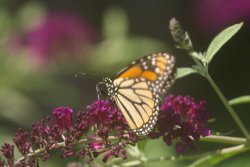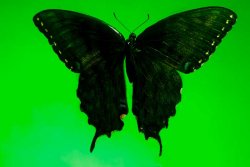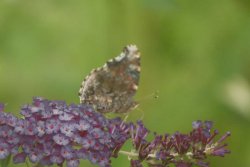Hi,
best green screen lighting and method to extract butterfly subject in special position & place into other photo?
First time poster here and I already did a search for this, but found nothing specific. As a hobby, I take photos of butterflies and other insects sometimes. This is very often done naturally (as in the images below), but I have also dabbled in sometimes rather extensive photo manipulation and compositing in Photoshop with the effect to keep everything as real looking as possible. It all depends on the insect, the state of the insect (whether live, dried, etc) and of course the flowers used and the background. With my latest project, I have run into a hangup and wanted to seek some advice here.
Suppose I want to take an already dried butterfly out of storage and add it to a photo similar to this one:

Such dried specimens have to be "relaxed" in a moist environment for a couple of days so that the wings and legs are moveable. Normally, then the wings are remounted into whatever new desired position and the specimen re-dried for a couple of days. A photo can then be taken with the specimen in front of a green screen and, as long as the lighting is correct, it is easy to extract the specimen from the screen and place in any photo desired. Works fine in this example due to the "flat" nature of the image and the fact that no legs are visible:

However, if the angle of the butterfly is as in the first image above or the one that follows, then the issue becomes the legs:

The legs break if an attempt is made to bend them when the specimen is dry, but they are quite movable after relaxation. However, outdoors, you can't just place a specimen into position (on a flower, for example) many times due to wind and other factors. Also, if more than one photo is to be taken, then the legs have to show movement.
To get around the legs issue, I was thinking of setting up indoors using a green fabric covered dowel rod or similar in front of a green screen that is already in the background. The dowel would simulate if the butterfly were on a flower with the rod being the flower itself. Might be able to substitute something other than a green dowel too. However, I see a couple of issues: 1) Since the butterfly legs are in direct contact with the green material, there is going to be color spillage of green into the black legs (making it more difficult to do a proper extraction of the legs) and (2) the dowel does not have a flat surface like the green screen does. I'm not exactly sure how to go about the lighting so extraction is not compromised. I just use a softened speedlight flash for images like the second down from the top one, but not sure how I would proceed in this instance.
Any help would be welcome. Hard to find anything specific on Youtube and the like either as far as I have been able to tell so far, but maybe I'm missing something.
Thanks in advance,
Jon
best green screen lighting and method to extract butterfly subject in special position & place into other photo?
First time poster here and I already did a search for this, but found nothing specific. As a hobby, I take photos of butterflies and other insects sometimes. This is very often done naturally (as in the images below), but I have also dabbled in sometimes rather extensive photo manipulation and compositing in Photoshop with the effect to keep everything as real looking as possible. It all depends on the insect, the state of the insect (whether live, dried, etc) and of course the flowers used and the background. With my latest project, I have run into a hangup and wanted to seek some advice here.
Suppose I want to take an already dried butterfly out of storage and add it to a photo similar to this one:

Such dried specimens have to be "relaxed" in a moist environment for a couple of days so that the wings and legs are moveable. Normally, then the wings are remounted into whatever new desired position and the specimen re-dried for a couple of days. A photo can then be taken with the specimen in front of a green screen and, as long as the lighting is correct, it is easy to extract the specimen from the screen and place in any photo desired. Works fine in this example due to the "flat" nature of the image and the fact that no legs are visible:

However, if the angle of the butterfly is as in the first image above or the one that follows, then the issue becomes the legs:

The legs break if an attempt is made to bend them when the specimen is dry, but they are quite movable after relaxation. However, outdoors, you can't just place a specimen into position (on a flower, for example) many times due to wind and other factors. Also, if more than one photo is to be taken, then the legs have to show movement.
To get around the legs issue, I was thinking of setting up indoors using a green fabric covered dowel rod or similar in front of a green screen that is already in the background. The dowel would simulate if the butterfly were on a flower with the rod being the flower itself. Might be able to substitute something other than a green dowel too. However, I see a couple of issues: 1) Since the butterfly legs are in direct contact with the green material, there is going to be color spillage of green into the black legs (making it more difficult to do a proper extraction of the legs) and (2) the dowel does not have a flat surface like the green screen does. I'm not exactly sure how to go about the lighting so extraction is not compromised. I just use a softened speedlight flash for images like the second down from the top one, but not sure how I would proceed in this instance.
Any help would be welcome. Hard to find anything specific on Youtube and the like either as far as I have been able to tell so far, but maybe I'm missing something.
Thanks in advance,
Jon
